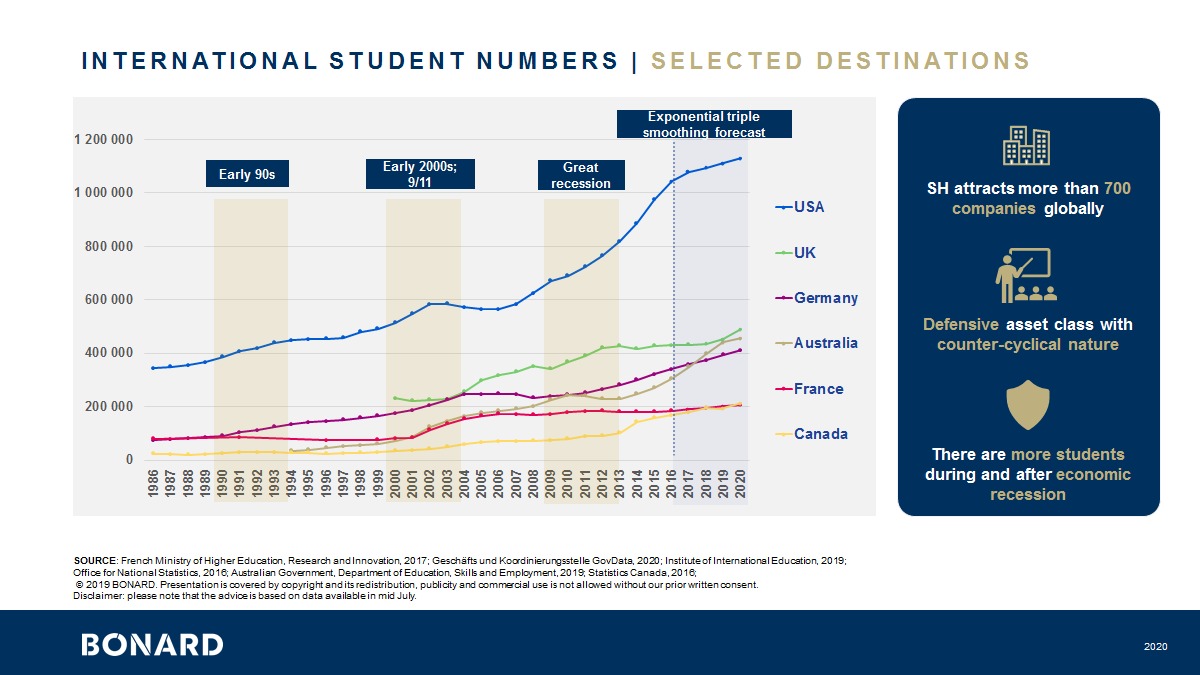 Credit: Scott Webb / Unsplash
Credit: Scott Webb / UnsplashStudent housing proves resilient, investments set to grow in 2021
December 14, 2020Real Estate
Although Covid-19 has impacted all sectors and asset classes, the effect has been less severe on student housing, an income-generating asset class which remains steady during good and bad times alike.
Student housing has the characteristics of, and has proven itself to be, a low-risk defensive asset class with a counter-cyclical nature: Over the last 70 years, there have been more students in and after every economic downturn. To date, the student housing sector has attracted more than 700 companies globally, with more expected to enter the arena in coming years.
As an alternative asset class, student housing has long outgrown its tentative beginnings. There are many opportunities and more than 200 portfolios, of which 75% have fewer than 5,000 beds, creating a benefit for investors interested in consolidation within this class. Today, major investors such as Greystar, Hines, Blackstone, and many others are making billions in student housing transactions.
According to a poll carried out by the GRI Club earlier this fall, investment appetite currently stands at very high levels: 65% of investors want to spend more in this asset class, 25% have put their investment on hold, and 10% have been considering divesting.
When we look at student housing demand over the course of this year, occupancies have decreased by up to 10% in most countries, against an original expectation of 20% or more. Most cities and private student housing properties in Germany, the UK, the Netherlands, and the CEE are reaching over 90% occupancy, followed by France, Spain, and Italy with an occupancy rate of around 80%. Older properties or products with a large number of shared rooms have attracted fewer clients.
Naturally, given the restrictions in place, the globally strong 18-year-old cohort has undertaken more domestic travel, which has partially replaced and helped offset the missing international students this academic year. In addition, students continued to arrive in fall even if universities were delivering online, preferring to be with their friends and social networks, as well as near better practice and job opportunities than those on offer at home. Moreover, private student housing adopted exceptional Covid-19 contingency plans and is now considered a better, even the best, accommodation option by many who would otherwise have opted for a shared apartment.
We see the year 2020 as a year of change. Rapid shifts around the world are also reflected in students’ preferences, especially in today’s “new normal”. According to Student.com data, there have been shifts in students’ preferred room types. Students’ interest in shared rooms is declining, due in particular to safety concerns. We are still seeing a growing trend for single studios, which are more and more in demand.
However, certain tendencies indicate that students are prolonging the decision-making process around booking accommodation in these new and uncertain times. Student.com data show an 11% increase y-o-y in students taking 6 months or more to book a room, suggesting they are spending extra time and research on confirming bookings due to travel uncertainty.

Despite the pandemic, the desire to study is expected to keep growing, proving the recession resilience of the student housing asset class. The forecast for next year predicts an increase in the overall number of students, also based on historical data which suggest that every period of economic downturn has led to greater demand for study. In addition, students will not want to postpone their studies too far, because the study space is age-limited. Moreover, students are thought to adapt better and more quickly to new circumstances and conditions.
The student housing asset class has proved to have strong long-term fundamentals. The pandemic has, naturally, had an impact but student housing is performing better than other asset classes, making it one of the most investable in 2021.
Student housing has the characteristics of, and has proven itself to be, a low-risk defensive asset class with a counter-cyclical nature: Over the last 70 years, there have been more students in and after every economic downturn. To date, the student housing sector has attracted more than 700 companies globally, with more expected to enter the arena in coming years.
As an alternative asset class, student housing has long outgrown its tentative beginnings. There are many opportunities and more than 200 portfolios, of which 75% have fewer than 5,000 beds, creating a benefit for investors interested in consolidation within this class. Today, major investors such as Greystar, Hines, Blackstone, and many others are making billions in student housing transactions.
According to a poll carried out by the GRI Club earlier this fall, investment appetite currently stands at very high levels: 65% of investors want to spend more in this asset class, 25% have put their investment on hold, and 10% have been considering divesting.
When we look at student housing demand over the course of this year, occupancies have decreased by up to 10% in most countries, against an original expectation of 20% or more. Most cities and private student housing properties in Germany, the UK, the Netherlands, and the CEE are reaching over 90% occupancy, followed by France, Spain, and Italy with an occupancy rate of around 80%. Older properties or products with a large number of shared rooms have attracted fewer clients.
Naturally, given the restrictions in place, the globally strong 18-year-old cohort has undertaken more domestic travel, which has partially replaced and helped offset the missing international students this academic year. In addition, students continued to arrive in fall even if universities were delivering online, preferring to be with their friends and social networks, as well as near better practice and job opportunities than those on offer at home. Moreover, private student housing adopted exceptional Covid-19 contingency plans and is now considered a better, even the best, accommodation option by many who would otherwise have opted for a shared apartment.
We see the year 2020 as a year of change. Rapid shifts around the world are also reflected in students’ preferences, especially in today’s “new normal”. According to Student.com data, there have been shifts in students’ preferred room types. Students’ interest in shared rooms is declining, due in particular to safety concerns. We are still seeing a growing trend for single studios, which are more and more in demand.
However, certain tendencies indicate that students are prolonging the decision-making process around booking accommodation in these new and uncertain times. Student.com data show an 11% increase y-o-y in students taking 6 months or more to book a room, suggesting they are spending extra time and research on confirming bookings due to travel uncertainty.

Despite the pandemic, the desire to study is expected to keep growing, proving the recession resilience of the student housing asset class. The forecast for next year predicts an increase in the overall number of students, also based on historical data which suggest that every period of economic downturn has led to greater demand for study. In addition, students will not want to postpone their studies too far, because the study space is age-limited. Moreover, students are thought to adapt better and more quickly to new circumstances and conditions.
The student housing asset class has proved to have strong long-term fundamentals. The pandemic has, naturally, had an impact but student housing is performing better than other asset classes, making it one of the most investable in 2021.








